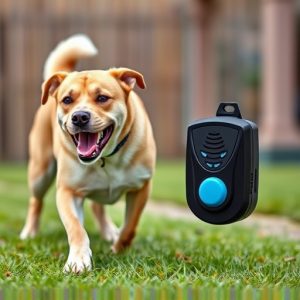Sound Wave Pet Control: Handheld Device’s Impact on Dog Behavior
Sound wave technology offers a humane, non-invasive pet behavior control method through handheld dev…….
Sound wave technology offers a humane, non-invasive pet behavior control method through handheld devices that emit ultrasonic waves invisible to humans but sensed by dogs, with coverage areas typically ranging from 10 to 50 feet. These devices are effective in addressing behaviors like barking and aggression by reinforcing desired behaviors. Their effectiveness depends on coverage area, and users should consider space layout for optimal results. Regular maintenance ensures long-term functionality, but animals can become accustomed to the sound.
“Unleash a new approach to pet behavior management with sound wave technology – a non-invasive and effective method for modifying canine conduct. This article explores the potential of handheld devices, examining their coverage area and overall effectiveness in deterring dogs. Delve into the benefits, considerations, and real-world applications, from successful stories to potential challenges, as we uncover how this innovative tool is transforming pet training. Discover why a sound wave dog deterrent could be the game-changer you’ve been searching for.”
- Understanding Sound Wave Technology for Pet Behavior Modification
- The Coverage Area: How Effective is the Handheld Device?
- Benefits and Considerations of Using a Sound Wave Dog Deterrent
- Real-World Applications: Success Stories & Potential Challenges
Understanding Sound Wave Technology for Pet Behavior Modification
Sound wave technology has emerged as a novel and non-invasive method for pet behavior control, offering a humane alternative to traditional training methods. This technology leverages specific sound frequencies to modify pet behavior, with the primary application being dog deterrents. Handheld devices emit ultrasonic waves that are inaudible to humans but can be sensed by dogs, triggering an instinctive response to avoid the area. The coverage area of these devices varies depending on factors like frequency, power output, and environmental conditions, typically ranging from 10 to 50 feet (3-15 meters). This technology is effective for addressing various issues, such as barking, jumping, and aggression, by reinforcing desired behaviors through sound cues.
For pet owners, the appeal lies in its convenience and effectiveness. Handheld dog deterrents allow users to address behavior problems on the spot, without the need for extensive training sessions or complex setups. The technology’s non-lethal nature makes it a preferred choice for responsible pet management, ensuring that pets are not harmed while being guided towards better behaviors. Understanding how sound wave technology works empowers owners to make informed decisions about their pet’s well-being and behavior modification.
The Coverage Area: How Effective is the Handheld Device?
The effectiveness of a handheld sound wave pet behavior control device largely depends on its coverage area. These devices typically emit high-frequency sounds that are inaudible to humans but can deter animals like dogs and cats. The coverage range usually varies between 30 to 100 feet, depending on the model and environmental factors such as obstacles and weather conditions. For indoor use, a smaller coverage area may be sufficient to control pet behavior in specific rooms or areas. However, for outdoor applications, particularly in larger yards or parks, devices with broader coverage are necessary to ensure consistent deterrence across the desired space.
A handheld device’s ability to control pet behavior depends on its ability to penetrate and cover the intended space effectively. Obstructions like walls, trees, or other buildings can reduce the sound wave’s range and intensity. Therefore, users should consider the layout of their spaces and choose devices that offer suitable coverage based on their specific needs. Additionally, some models include adjustable settings for different scenarios, ensuring versatility in controlling pet behavior across various environments and conditions.
Benefits and Considerations of Using a Sound Wave Dog Deterrent
Sound wave dog deterrents offer a unique and non-lethal approach to pet behavior control, providing numerous benefits for both homeowners and their furry companions. One of the key advantages is their wide coverage area; these devices can effectively target and disrupt dogs from a distance, making them ideal for large yards or areas where traditional barriers might not be feasible. This feature ensures that pets are deterred without compromising the aesthetics or functionality of your outdoor space.
When considering a handheld sound wave dog deterrent, it’s essential to balance its effectiveness with potential drawbacks. While many dogs find the high-frequency sounds unpleasant, sensitivity varies among breeds and individuals. Users should also be mindful of the device’s range and ensure proper placement for optimal results. Regular maintenance and charging are additional considerations to keep the device functioning effectively over time, ensuring a continuous solution for managing pet behavior in your desired coverage area.
Real-World Applications: Success Stories & Potential Challenges
Sound wave pet behavior control has found real-world applications in various settings, offering innovative solutions for managing animal behavior with minimal harm. One notable success story is its use as a handheld dog deterrent. This technology enables pet owners and professionals to safely and humanely train dogs without resorting to traditional, often stressful methods. By targeting specific frequencies, these devices can prompt unwanted behaviors to cease without causing physical pain or distress.
Despite these successes, challenges remain. The effectiveness of sound wave deterrents varies based on factors like the device’s coverage area and the animal’s species, size, and temperament. Additionally, some animals may become accustomed to the sound over time, requiring adjustments in training methods. Moreover, ensuring the safety and well-being of both pets and users is paramount, necessitating careful consideration of potential side effects and proper usage guidelines.
Sound wave technology for pet behavior control offers a non-invasive and humane approach to modifying canine behavior, with significant benefits in terms of both effectiveness and user experience. The handheld device’s coverage area is a key consideration, ensuring it can reach the desired space without requiring excessive power or frequent recharging. Real-world applications have shown success in deterring unwanted behaviors like barking, jumping, and aggression, but challenges may arise from inconsistent usage or environmental factors. Ultimately, a sound wave dog deterrent can be a valuable tool for pet owners when used responsibly and in conjunction with positive reinforcement training methods.


